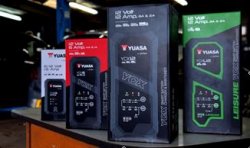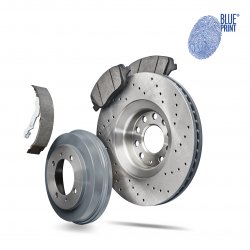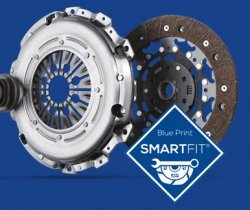Professionals to DIY
We're Online 9am - 5pm
On Orders Over £30
Yuasa Batteries - YCX Smart Battery Chargers & Maintainers

Yuasa Batteries take charge with development and launch of YCX Smart Battery Chargers and Maintainers.
Quiet Effective Brakes - Noise, Vibration and Harshness (NVH)

Quiet Effective Brakes - Noise, Vibration and Harshness (NVH)
Blueprint Self Adjusting Clutch Solution

Blueprint Self Adjusting Clutch Solution
Be smart with Blueprint for a professional and cost effective clutch replacement solution for self adjusting Clutches.
Skoda Octavia 2.0TDI Dayco Timing Belt Kit Installation

Skoda Octavia 2.0TDI Dayco Timing Belt Kit Installation
The 2.0-litre TDI diesel engine used in the Octavia from 2008, features a timing belt driven water pump. As replacing the belt also requires the auxiliary drive system to be removed, Dayco recommend that all the systems’ components - primary drive and auxiliary drive - be replaced at the same time.
This step-by-step technical guide will help technicians through the process, to avoid complications and ensure a first-rate job.
As with all primary drive system jobs, the work should be undertaken when the engine is cold, so ideally the vehicle will not have been run for at least four hours.
Remove the plastic cover to reveal the engine, followed by the mudguard moulding under the right hand wheel arch, which will allow access to the auxiliary drive system, then remove the tensioner and auxiliary belt.
Remove the tie rod beneath the engine and then the crankshaft, or TVD, pulley in order to remove the lower and central timing belt covers. Then from the top of the engine move the differential pressure sensor of the FAP with its bracket and the electric fuel pump with its bracket, followed by the fuel filter and cooling circuit tank, to be able to then remove the top timing belt cover.
Remove the lower bolt of the engine mounting bracket flange, correctly support the engine and then remove the upper right engine mounting bracket, followed by the bracket flange.
Rotate the crankshaft clockwise to match the timing reference marks on the pulley and lock the pulley in place using Dayco
tool T10050 (figure 1).
Euroflo - Ultra Premium Emission Systems
Euroflo - Ultra Premium Emission Systems
With what is already the biggest range of Exhausts, Catalytic Converters and DPFs in the UK aftermarket, you might think that EuroFlo are happy to rest on their laurels. Well, it couldn’t be further from the truth
Every year EuroFlo develops and delivers hundreds of brand new part numbers into their already huge range.
So, how does that happen? The answer may surprise you...
Planning & Development
The planning and development of a new EuroFlo part number begins as soon as a new vehicle arrives on the roads.
The first step is to create a part number for each component which enables them to accurately gauge customer demand when it begins. They carefully record all requests and when demand is deemed to be sufficient, actual part number component
development begins.
The first step in the development process is to purchase several original equipment samples. These samples are carefully studied,
measured and de-constructed. Using specially designed software, EuroFlo engineers determine precisely the type of raw material to use for each component, as well as all of the operations required to produce it. The software also helps to identify the correct tooling, settings and tolerances.
Quality Control Plan
Once they have all of the required measurements and related information, they create a Quality Control Plan which specifies a detailed set of instructions for manufacturing every single individual component which will make up the new part number.
This Quality Control Plan is used during production to enable operators to assess and maintain the highest quality standards at each step of the production process.
Bullet Proof Jigs
Jig construction now begins. Jigs are an essential tool for exhaust system production and a major investment.
Exhausts are increasingly complex in design and in order to achieve their market leading quality standards, the jigs have had to become even better. When properly engineered, constructed and maintained, jigs are the best practical way of guaranteeing intricate and complicated geometric specifications are met, so consistently ensuring good fitment experiences.
In order to prevent thermic deformation, a great deal of planning goes into the location of fixation devices such as pins, levers, clamps and stoppers.
Highly engineered, heavy duty ‘bullet proof’ jigs are a feature of EuroFlo production, ensuring high quality products and consistent fitment every time.
All jigs are approved and signed off by the Quality Controller before being released into the production process.
Preliminary Production
preliminary production begins with a short run which enables them to fully test the production process. At this point,
they enable feedback from the operators who may suggest more efficient processes to optimise production. All suggestions are considered by the Production Director, who decides whether to implement them.
Testing & Homologation
When the new component goes into production, homologation certification is carried out by performing real life tests on a specification approved vehicle by an official approved testing centre.
These tests ensure that the new EuroFlo product performs at least as well as (and often better than) the OE product.
Only once they have carried out all of these steps, can they release the new component into the marketplace.
National Distribution Centre
The new products are moved into their National Distribution Centre to join the existing stockholding of approximately half a million exhausts, catalytic converters and DPFs.
Every day thousands of EuroFlo emissions components are dispatched from the National Distribution Centre to 10 strategically located regional distribution centres, ensuring that stock is
available when required.




